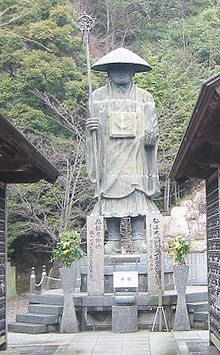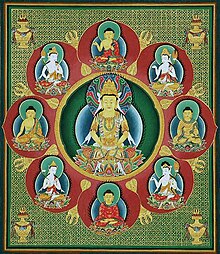Shingon-shu



Shingon-shū ( Japanese 真言 宗 , literally 'school of the true word') is one of the monk Kūkai ( 空 海 , 774-835), who is also revered as Kōbō Daishi ( 弘法 大師 , 'grand master of teaching dissemination '), founded in 807 Buddhist school in Japan . Together with the Tendai School, it is also known as Mikkyō ( 密 密 , 'secret teaching', 'hidden teaching'), in the West as esoteric Buddhism and has its roots in the Chinese tradition of the Mizong (密宗esoteric school ) or des Tantrism . Shingon is the Sino-Japanese reading of the Chinese term Zhēnyán ( 真言 , literally 'true word'), a translation of the Sanskrit term mantra (मन्त्र).
particularities
- At the center of worship is the Buddha Vairocana , who unites the wisdom of all Buddhas and is considered a cosmic Buddha who conditions everything.
- The human being has the possibility of attaining the Buddha's status through (esoteric) practices in this life.
- The use of mantras (magical syllables) and signs (mudras) play a major role in the meditations . Meditation on the Sanskrit symbol for A as the highest mantra (Japanese A-Jikan , 阿 字 観 ) is particularly important .
- The main texts are the Mahavairocana Sutra (Japanese Dainichi-kyō , 大 日 経 ) and the Vajrashekhara Sutra (Japanese Kongōchō-gyō , 金剛 頂 経 ), which regardless of their designation as sutras in esoteric Buddhism also serve as tantras.
- The teachings are illustrated in the ' mandalas of the two worlds' ( Ryōkai Mandara , 両 界 曼荼羅 ): the 'diamond world' ( Sanskrit Vajradhātu , Japanese Kongōkai 金剛 界 ) and the 'womb world' (Sanskrit Garbhadhātu , Japanese Taizōkai 胎 蔵界 ).
Teaching
Kūkai has explained and systematized his concepts in over 50 papers. Six of them still receive special attention today:
- Ben-kenmitsu-nikyō-ron. ( 辯 顯 密 二 教 論 ), a treatise that compares exoteric Buddhism with esoteric Buddhism and gives priority to the latter
- Sokushin-jōbutsu-gi. ( 即 身 成佛 義 ), a treatise on the realization of Buddhahood in this life
- Shōji-jisso-gi. ( 聲 字 實 相 義 ), a treatise on the perception of the wisdom of Vairocana
- Unji-gi. ( 吽 字 義 ), a treatise on the mantric syllable " Om " (Aum)
- Hizō-hōyaku. ( 秘 蔵 寶 鑰 ), a treatise on the ten stages of spiritual advancement
- Hannyashingyō-hiken. ( 般若 心 經 秘 鍵 ), a 'secret key' to the Prajnaparamita-hridaya Sutra
The most important is the doctrine of the realization of Buddhahood in this life, which arose between 824 and 833. At this point Kūkai opposed the tradition, according to which humans usually only reach this state after three aeons (Sanskrit asamkhyakalp ). Similar ideas can also be found in the teachings of Huìguǒ and in Buddhism of the Tendai school ( Tendai-shū ).
According to tradition, Vairocana is said to have dictated the sacred sutras himself. After his death, the writings were kept in an iron stupa ( burial mound ) for 800 years . The historical Buddha Shakyamuni and his teachings are only considered a manifestation of Vairocana. Through the union of the cosmic Buddha Vairocana with the abstract being of the Dharmakaya (ultimate reality ), Kūkai developed a figure that embodies the union of the whole of existence. So it was assumed that the form of Vairocana underlies all earthly things. The aim of Shingon Buddhism is to unite the experience of one's own body gained through meditation and practice with the figure of Vairocana. For this an initiation into the secret teachings is necessary, which are handed down orally. The reception is carried out in a sacred ritual (tantra), in which the speaking of mantras plays an important role.
History and foundation
In 804, the young, as yet unknown Kūkai found the opportunity to cross over to China and moved to Chang-an ( 長安 ; today Xi'an , 西安 ), where he lived in the Qinglong Temple ( 青龍寺 , "Temple of the Blue Dragon") Began studying Buddhism.
The meeting with the famous teacher Huiguo ( Chinese 惠 果 , Pinyin Huìguǒ , W.-G. Hui-kuo ) (746–806), who was the first to systematize a number of disparate elements of Indian and Chinese esoteric Buddhism, was decisive for his further life and spent the last months before his death instructing Kūkai in the concepts and practice of Shingon. Almost all Japanese monks in China conducted their studies using Chinese translations, but Kukai also delved into the Sanskrit originals. He soon began to develop his own synthesis based on the concepts developed by Huigo, with the cosmic Buddha Vairocana at its center.
After the death of the revered Huiguo, he returned to Japan in 806, but had to wait on the island of Kyushu, since he had prematurely broken off his stay in China, until he was allowed to travel to Kyoto . Three years later he was thanks to the support of the Tenno Junna abbot of the local Tō temple ( 東 寺 , Tō-ji ), in which he u. a. performed official rituals for the imperial family and the state. His outstanding talent as an artist and thinker contributed significantly to the spread of the new teaching. In 819 he began to build another center in an 800 m high plateau surrounded by eight peaks east of Wakayama ( Wakayama Prefecture ). The temple was given the "mountain name" Kōya-san , which is used today from a quasi-geographical name. There are still over 110 temples here today. The mausoleum of Kūkai (Oku no in) can be found in the back of an extensive forest cemetery.

cleavage
The popularity of Shingon Buddhism declined sharply towards the end of the Heian period , as the growing prosperity of the monasteries had corrupted the way of life of many monks. Among the attempts to remedy the grievances, that of Kakuban ( 覚 鑁 ; 1095–1143) was particularly momentous. Kakuban from Kyushu lost his parents at an early age and had lived in the monastery since he was 13 years old. Thanks to a superior intelligence, he was ordained at twenty. Ten years later, with the support of influential people from Kyoto, he built the Denbō-in ( mit 法院 ) temple on the Kōya-san.
His attempts at reform initially yielded some success, so that he temporarily held the leadership of the entire temple district. However, the growing tensions with monks from other monasteries led to armed opponents burning the Dembo Temple in 1139. Kakudan and 700 monks moved to the Negoro Temple ( Negoro-ji , 根 来 寺 ) in the south of the Kii Peninsula . Here he died in 1143 at the age of 49. Later attempts at reconciliation between the camps were unsuccessful, and the Negoro Temple developed into the center of the 'New Shingon Teaching' ( 新 義 真言 宗 , Shingi Shingon ).
The scholarship of the monks there was also noticed by the Jesuits, who had been missionary in Japan since the mid-16th century. In their writings, Negoro is referred to as the seat of the largest 'university' in the country, which is why the name is featured on many contemporary Portuguese maps. However, as in larger temples in other schools, militarization occurred. From the point of view of the general Toyotomi Hideyoshi, the power of these warrior monks ( Sohei ) represented a threat in the struggle for supremacy over the empire. After a siege in 1585, most of the huge temple settlement was destroyed. During the Edo period, the temple and the teaching direction were restored, but Negoro never returned to its former size.
In addition to the 'New Shingon', other smaller denominations emerged such as the 'Chizan branch' ( 真言 宗 智 山 派 , Shingon-shū Chizan-ha ) and the ' Buzan branch' founded in the 16th century by the monk Senyo Sōjō ( 専 誉 僧 正 ) '( 真言 宗 豊 山 派 , Shingon-shū Buzan-ha ).
Works
- Kukai: Major Works. Translated, with an account of his life and a study of his thought by Yoshito S. Hakeda. Columbia University Press, New York 1972, ISBN 0-231-03627-2 .
literature
- Roger Goepper (Ed.): Shingon: The Art of Secret Buddhism in Japan. An exhibition by the Museum for East Asian Art of the City of Cologne, the Japan Foundation, Tôkyô, and the Tôkyô National Museum with the participation of the Nara National Museum. Museum for East Asian Art of the City of Cologne, Cologne 1988, DNB 890441812 . (Catalog)
- Rolf Giebel, transl .: The Vairocanābhisaṃbodhi Sutra, Numata Center for Buddhist Translation and Research . Berkeley 2006, ISBN 978-1-886439-32-0 PDF ( Memento of February 10, 2013 in the Internet Archive )
- Rolf W. Giebel, Dale A. Todaro; trans .: Shingon texts. ( Memento of March 22, 2015 in the Internet Archive ) Numata Center for Buddhist Translation and Research, Berkeley CA 2004, ISBN 1-886439-24-9
- Gregor Paul : On Kukai's philosophy of language. In: Gregor Paul (Ed.): Cliché and Reality of Japanese Culture - Contributions to literature and philosophy in Japan and to the image of Japan in German-language literature. P. Lang, Frankfurt am Main / New York 1987, ISBN 3-8204-9599-1 .
- Hirasawa Shōsō: Shingi shingon shū no rekishi to shisō. (History and thought of the New Shingon School). Nonburu-sha, Tokyo 2007, ISBN 978-4-903470-23-8 .
- Minoru Kiyota: Shingon Buddhism: Theory and Practice . Buddhist Books International, Los Angeles / Tokyo 1978.
- Daigan Lee Matsunaga, Alicia Orloff Matsunaga: Foundation of Japanese Buddhism ; Vol. I; The aristocratic age . Buddhist Books International, Los Angeles / Tokyo 1974, ISBN 0-914910-25-6 .
- Taiko Yamasaki: Shingon. Esoteric Buddhism in Japan. Theseus, Zurich / Munich 1990, ISBN 3-85936-032-9 .
- Hôryû Toki, Seiichi Kawamura, tr: Si-do-in-dzou; gestes de l'officiant dans les cérémonies mystiques des sectes Tendaï et Singon . E. Leroux, Paris 1899.
Remarks
- ↑ Inagaki, Hisao (1972). " Kukai's Sokushin-Jobutsu-Gi ( Memento from March 23, 2015 in the Internet Archive )" (Principle of Attaining Buddhahood with the Present Body), Asia Major (New Series) 17 (2), 190-215
- ^ Giebel, Todaro (2004), pp. 63-82
- ↑ A group of monks sponsored by the Tenno set out in four ships, only two of which reached the mainland. At its head was the later founder of the Tendai school Saichō ( 最澄 , 767 - 822 ), an established and influential monk. Kūkai was on board Saichō's ship. This encounter initiated an initially friendly, later antagonistic relationship that had a significant impact on the lives of both.
- ↑ Many western authors put the year of death at 805. According to the Chinese calendar, Huiguo died on the 15th day of the 12th month in the first year of the currency Yongzhen (永貞 元年 12 月 15 日), which is why the year of death falls on January 12, 806 in Western times.
- ↑ There is no mountain of that name.
Web links
- Shingon Buddhist International Institute: HeavenEarth Net (English, Japanese)
- Koyasan Shingon Temples


